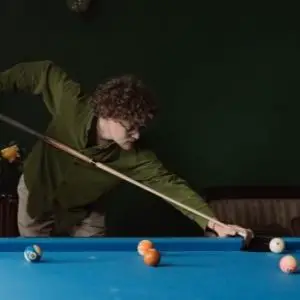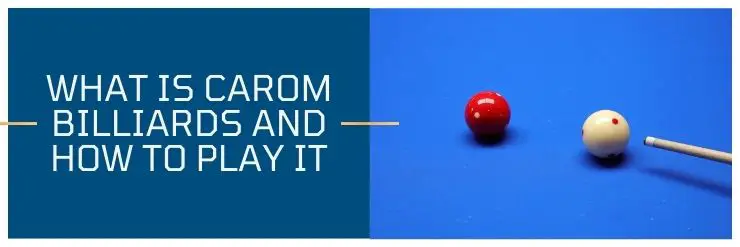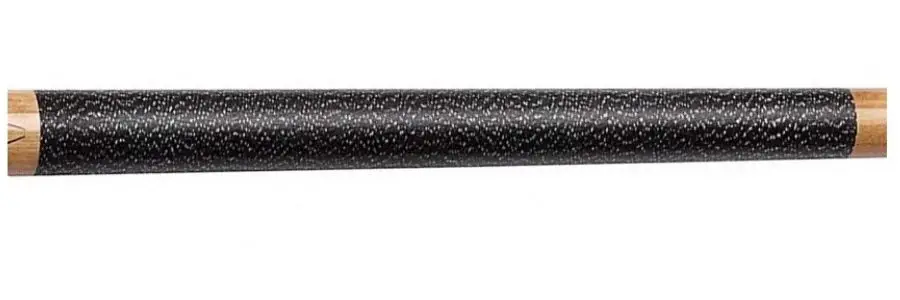Cutthroat pool— also known as three-man-screw— is a popular variation of billiards. Unlike the traditional 8-ball game, Cutthroat is played with three players (or five) and is all about the defense play style. The objective of the game is to have your ball be the last ball remaining on the table. Think you have what it takes to win? Read on to learn more on how to play cutthroat pool.
The Basic Idea
Before diving into the nitty-gritty rules, here’s a quick rundown to give you a clearer idea of Cutthroat:
- Instead of aiming for your balls, you want to sink your opponents’ balls instead
- Shoot until you miss — if you get one ball in a pocket, you continue shooting until you miss (or until you scratch or your shot is illegal)
- If a player has all of their balls pocketed, they’re out
- To win you must be the last one standing
- BONUS: if you’ve been eliminated you can still come back, but you must wait until an opponent commits a foul
want to know what is a scratch in pool, check out my article answering just that.
Rules and Setup
Cutthroat is played with a standard pool ball set. This includes balls numbered 1-15 and the cue ball.
Need a decent set of balls for your table, check out my best pool balls here

Dividing the Balls
Each player gets the same number of balls, which are assigned numerically. First, we’ll break down the groupings, and then we’ll cover how to decide who gets which group.
If you’re playing with three people, the balls are divided as follows:
- Player 1: balls 1-5
- Player 2: balls 6-10
- Player 3: balls 11-15
If you’re playing with five people, the balls are divided as follows:
- Player 1: balls 1-3
- Player 2: balls 4-6
- Player 3: balls 7-9
- Player 4: balls 10-12
- Player 5: balls 13-15
Assigning Groups
There are three common ways to assign which player gets which group of balls.
- Assigning groups before the game starts. Doing this is probably the simplest, but it has a downside. Since the objective is to get your opponents’ balls into the pockets, it’s not usually an advantage to be the one to break if you’ve preassigned your groups. You might accidentally get one of your own balls in.
- Claim a group as soon as you pocket a ball. This method is also pretty simple. No groups are assigned before the game starts, but the first player to pocket a ball gets to choose their group. The second player to pocket a ball gets to choose as well, and the third is left with the remaining group.
- Traditional method. This one is trickier. In order to claim a group using the traditional method, you have to pocket a ball from each of the other groups.
Racking
To rack for Cutthroat use a standard triangle rack. Place the 1-ball at the topmost tip of your triangle, and the 6-ball and 11-ball at the other corners. The remaining balls are placed randomly in the triangle.
Breaking
In Cutthroat you want to use an “open break.” This basically means that a minimum of 4 balls have to be driven from the rack and hit the cushions for the break to count and the game to start. This helps spread the balls out and makes playing less frustrating at the beginning.
Shot Calling
When playing Cutthroat you need to decide— before the game starts— whether or not you’ll only be counting “called shots.” This means that each player must announce which ball they plan to sink into which pocket before they take each shot. If they accidentally sink an unintended ball in the process, it’s considered an illegal shot. If a player makes an illegal shot they must forfeit their turn.
Legal vs. Illegal Shots
In order for a shot to be considered legal, it cannot make contact with one of your balls first. I.e. it must hit an opponents’ ball first.
Every shot must also result in either an opponents’ ball being pocketed or any of the numbered balls to hit the cushions. This helps make sure people aren’t playing it safe until the table setup looks more appealing for them.
Penalties and Fouls
You can commit fouls in several ways during a game of Cutthroat, so be sure to read the rules closely!
- Pocketing an opponents’ ball on an illegal shot. If you make an illegal shot and an opponents’ ball goes in, this is a foul. Most commonly this occurs when you hit one of your balls first before hitting theirs.
- Jumping an opponents’ ball. Jumping an opponents’ ball off the table is another way to make a foul. Jumping one of your own balls, though, just means you spot that ball. Jumping the cue ball is a scratch.
When a foul is committed, each of your opponent’s pocketed balls is returned to the table. This means that all eliminated players are brought back in as well.
FAQ: How to Play Cutthroat Pool
As with all games, there will always be some concerns with unanswered questions – with this frequently asked question section on how to play cutthroat, i look at answer some of them for you.
What happens when you commit a foul and no balls are pocketed?
If you commit a foul when no balls are pocketed, you ignore the penalty.
What happens after you scratch during Cutthroat?
If you scratch— sink the cue ball— during a game of Cutthroat, the next player gets to place the cue ball anywhere they’d like, as long as it’s behind the head-string. The head-string, for those who are unfamiliar, is an imaginary line between the two diamonds in the middle of the table on the breaking end.
Do groups have to be divided in numerical order?
Per the rules of the game, you should divide the ball groups in a numerical order. This helps keep everything straight during gameplay.
In Summary
Cutthroat is a fun game to play when you have a lot of friends who want to play at one time, or if you’re just bored of traditional billiards. This guide on how to play cutthroat pool should get you and your friends playing in no time! The penalty/foul system adds an exciting element, as well, because you never know how the tides could turn. Next time you’re looking for something fun to do and you’re near a billiards table, give Cutthroat a try!
Rob is an avid player and fan of all cue sports, particularly 8-ball, and snooker. He has competed in a few local 8-ball tournaments and although he is not a professional, he can compete with the best of them.









